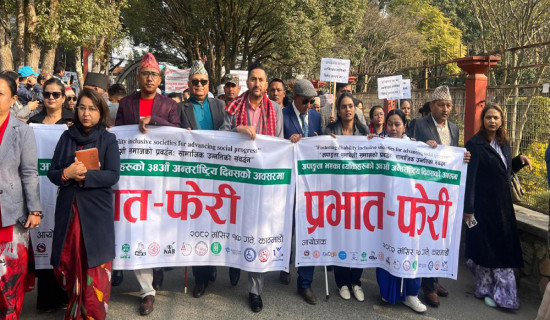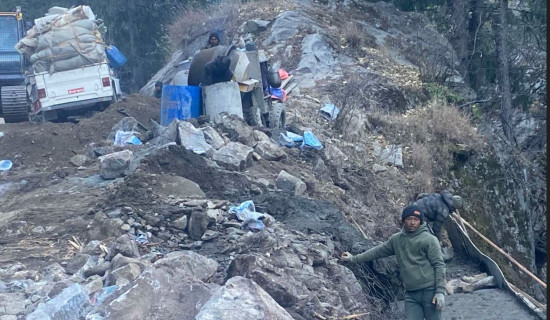- Wednesday, 3 December 2025
Awareness Key To Suicide Prevention
Suicide is emerging as a serious public health issue today. According to the World Health Organisation (WHO), more than 726,000 persons kill themselves globally every year. Considered as the third major cause of death among people belonging to the age-group of 15-29 years, suicide is increasingly becoming a serious problem in developing as well as developed nations. As a global phenomenon, suicide seems to have emerged as a leading cause of death in many countries. However, the global health body’s report shows that a whooping 73 per cent of global suicides took place in low- and middle-income countries in 2021.
Factors
Social, cultural, economic, biological, psychological and environmental factors are the main causes leading to suicide. Psychiatrists hold rising mental illnesses like depression responsible for increased suicide rates. Apart from individuals’ mental health and well-bring, their performance, physical condition, job performance, financial hardships and deprivation, and overall life satisfaction are other reasons for suicide. Academic pressure and a lack of economic opportunities are often found causing young people to opt for suicide.
A study shows that students have higher-than-average suicide rates in South Korea. One of its reasons is that they feel high levels of burden to achieve their academic success. Excessive use of alcoholic beverages, stress, sleep deprivation and poor social relationships are additional factors making them vulnerable to suicide. As the country having one of the highest suicide rates worldwide, South Korea also records many elderly people killing themselves annually because they remain isolated from their children. In developed nations, the link between suicide and mental disorders and a previous suicide attempt is regarded as customary. It is believed that an individual suffering with depression is twenty times more likely to die by suicide than someone without the disorder. No doubt, suicides and suicide attempts can have a ripple effect on families, friends, colleagues, communities and societies.
Similarly, a study conducted in the United States indicated that 20 per cent of suicides between 2003 and 2020 had something to do with breakups, conflict and divorce. The study found that intimate partner problems caused one in five suicides. These problems include life stressors like unemployment and family-related issues such as divorce, separation, romantic breakups, arguments, conflict and intimate partner violence. Suicides also occur rashly in movements of crisis when individuals lose their capacity to tackle life stresses like financial difficulties, relationship disputes or chronic pain and illness.
In Nepal too, suicide rates have been on the rise over the years, reaching an alarming level. The Nepal Police records show that more than 6,000 persons kill themselves every year. This means as many as 16 persons lose their lives due to suicide. In the first six months of the current fiscal year, a total of 3,134 persons died by suicide. This figure is almost double the number of people losing their lives in road accidents.
One out of five death cases registered with the police accounts for suicide. The numbers of suicide cases might be more than the official figures because many suicide incidents go unreported. This is mainly because of social stigma. Thus, a previous suicide attempt is a major risk factor for suicide in the general population.
With gradual changes in people’s occupations and lifestyle even in Nepal, life seems to have now become more stressful than ever before. When life turns tense, it naturally causes mental and emotional disorders. Consequently, people tend to be desperate and start losing their interest in life. This may lead them to committing suicide. As competition is everywhere, even young children in Nepal are also under pressure to perform better academically. And they cannot stay with the family. Growing substance abuse among youths has now emerged as an alarming problem. This may also make them take irrational steps like killing themselves. Adults have a tendency to go abroad for pursuing higher education or finding a job, leaving the elderly in home. The elderly people are supposed to get care from their offspring. But when they are deprived of care, they feel neglected and isolated. Thus, the frustrated lots are at increased risk of suicide.
Being a severe public health issue, suicide requires an effective public health response. This problem can be prevented to a great extent by making timely and evidence-based interventions. With the support from the WHO and other partners, the Government of Nepal has stepped up some important measures to prevent suicides. A national suicide action plan has also been formulated to deal with this problem. Based on the WHO’s LIVE LIFE initiative, the country has embraced a multifaceted approach to preventing suicide. Acknowledging the nature of suicide, the government aims at engaging stakeholders in this process.
Collaboration
It is worth mentioning that the Ministry of Health and Population (MoHP), in collaboration with WHO, organised numerous policy dialogues to engage local government representatives in the implementation of community-based approaches to mental health and suicide prevention. As people are often found using highly hazardous pesticides to kill themselves, the government has adopted the policy of phasing out such matters in order to help prevent suicide. It has put a ban on more than two dozen of such pesticides. In addition, hundreds of journalists have also been trained on responsible media reporting practices. Similarly, a round-the-clock suicide prevention helpline has been in operation to provide counselling on suicide prevention to those in need. Raising awareness and providing counselling to those at risk of committing suicide can be effective in preventing this anomaly.
(The author is a former deputy executive editor of this daily.)












-original-thumb.jpg)



